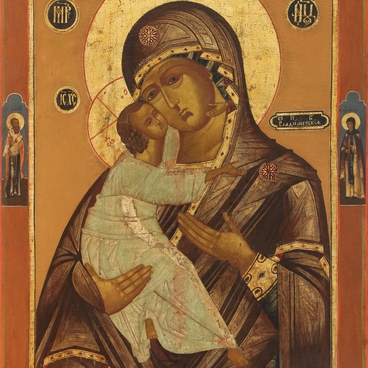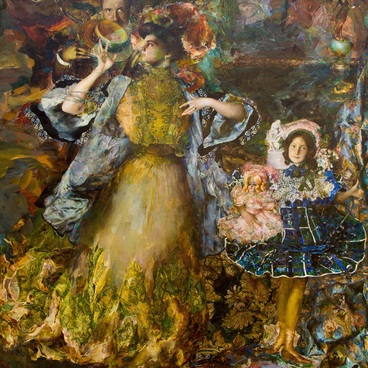The icon collection of the Khanty-Mansiysk State Museum of Fine Arts has an icon of the Virgin Hodegetria of Tikhvin with the Child Jesus Christ, painted by an unknown master in the late 18th-early 19th century. The painting of the Theotokos with the Child Jesus follows the type of Our Lady of Tikhvin, the only difference being that in the museum’s version the artist used a chest-high image of the Virgin Mary instead of the canonical half-length.
The image of Our Lady of Tikhvin is one of the oldest versions of Hodegetria (“She who shows the way”). The lore has it that the image was painted by the evangelist Luke himself. In this iconographic type, the Child is sitting in his mother’s arms. He has fingers of his right hand folded in a blessing gesture, holding a scroll in his left hand, a symbol of glad tidings, or Gospel. The mother’s and the Child’s heads are facing each other but not touching. In Hodegetria, the baby Jesus is at the centre of the composition, and the Mother of God points to him with a gesture or inclined head.
The Virgin Hodegetria from the collection of the Khanty-Mansiysk Museum is shown wearing a reddish-purple maphorion, a long lady’s shawl which covers her from head to feet. The gold star over the forehead symbolizes the Virgin at the time of the birth of Jesus, the one on her right shoulder, the Virgin before his birth, and on the left, the Virgin after the birth. The artist painted the halos in gold tracing them with a reddish-brown paint; the background is also in gold and the edges are painted in dark ochre.
Our Lady of Tikhvin, which this icon from the museum collection replicates, was transferred in the 5th century from Jerusalem to Constantinople, where it was housed in the Blachernae Cathedral built for it. The legend has it that in 1383, 70 years before the Turks invaded Constantinople, the icon disappeared from the cathedral and reappeared, surrounded by radiant light, over the waters of the Ladoga Lake. It stopped near the town of Tikhvin, where a wooden Assumption church was founded first, and a monastery later.
The appearance of the icon and all of its history are full of miracles which are detailed in the Story of the Icon of Our Lady of Tikhvin from the first half of the 16th century. With time, new miracles and events entered into the narrative. During WWII, the ancient icon disappeared. In 2004, it was solemnly returned to the Tikhvin Monastery of Our Lady Assumption. There are many versions of the image, and it is one of the most revered icons of the Russian Orthodox Church.
The image of Our Lady of Tikhvin is one of the oldest versions of Hodegetria (“She who shows the way”). The lore has it that the image was painted by the evangelist Luke himself. In this iconographic type, the Child is sitting in his mother’s arms. He has fingers of his right hand folded in a blessing gesture, holding a scroll in his left hand, a symbol of glad tidings, or Gospel. The mother’s and the Child’s heads are facing each other but not touching. In Hodegetria, the baby Jesus is at the centre of the composition, and the Mother of God points to him with a gesture or inclined head.
The Virgin Hodegetria from the collection of the Khanty-Mansiysk Museum is shown wearing a reddish-purple maphorion, a long lady’s shawl which covers her from head to feet. The gold star over the forehead symbolizes the Virgin at the time of the birth of Jesus, the one on her right shoulder, the Virgin before his birth, and on the left, the Virgin after the birth. The artist painted the halos in gold tracing them with a reddish-brown paint; the background is also in gold and the edges are painted in dark ochre.
Our Lady of Tikhvin, which this icon from the museum collection replicates, was transferred in the 5th century from Jerusalem to Constantinople, where it was housed in the Blachernae Cathedral built for it. The legend has it that in 1383, 70 years before the Turks invaded Constantinople, the icon disappeared from the cathedral and reappeared, surrounded by radiant light, over the waters of the Ladoga Lake. It stopped near the town of Tikhvin, where a wooden Assumption church was founded first, and a monastery later.
The appearance of the icon and all of its history are full of miracles which are detailed in the Story of the Icon of Our Lady of Tikhvin from the first half of the 16th century. With time, new miracles and events entered into the narrative. During WWII, the ancient icon disappeared. In 2004, it was solemnly returned to the Tikhvin Monastery of Our Lady Assumption. There are many versions of the image, and it is one of the most revered icons of the Russian Orthodox Church.

